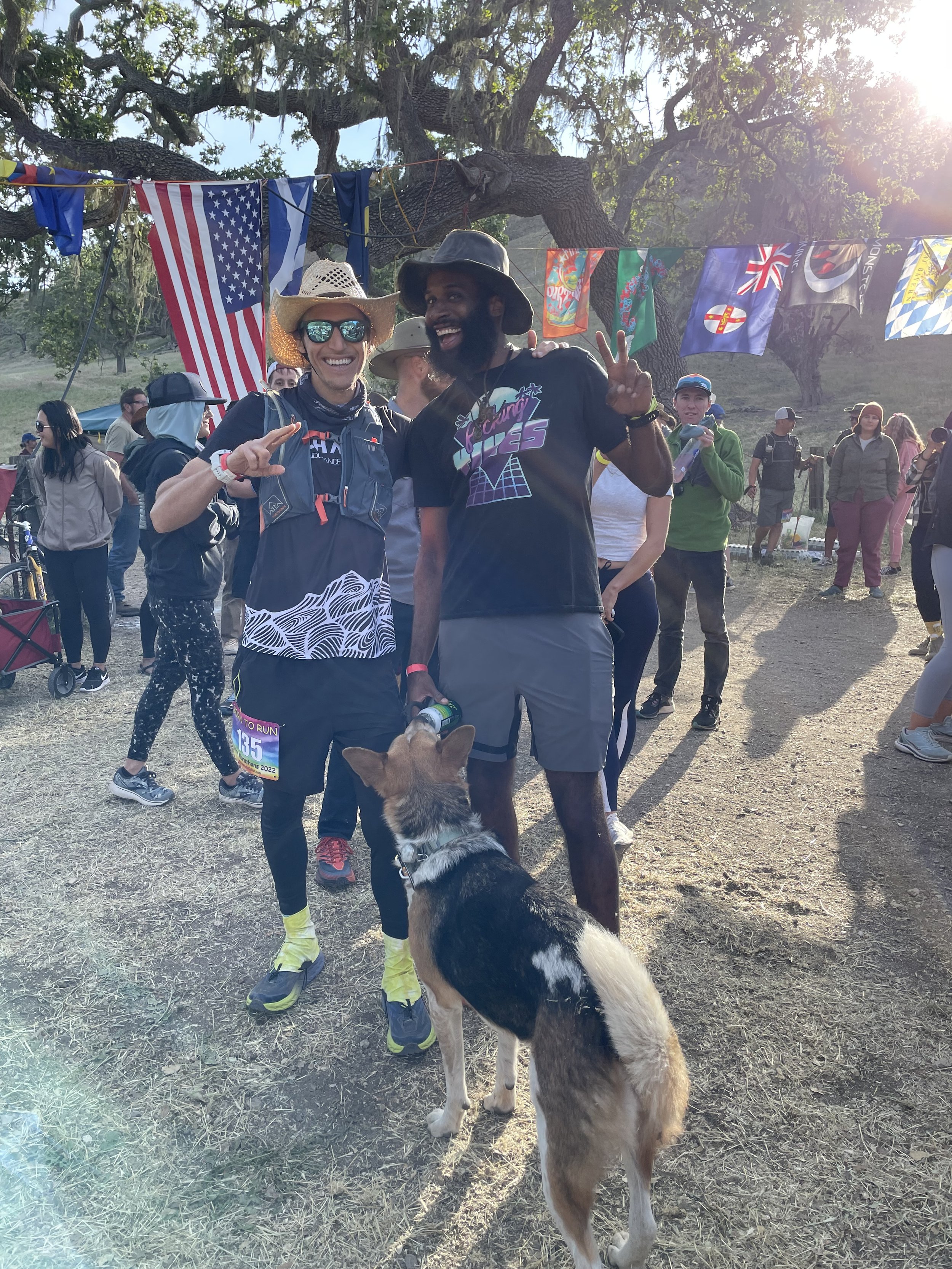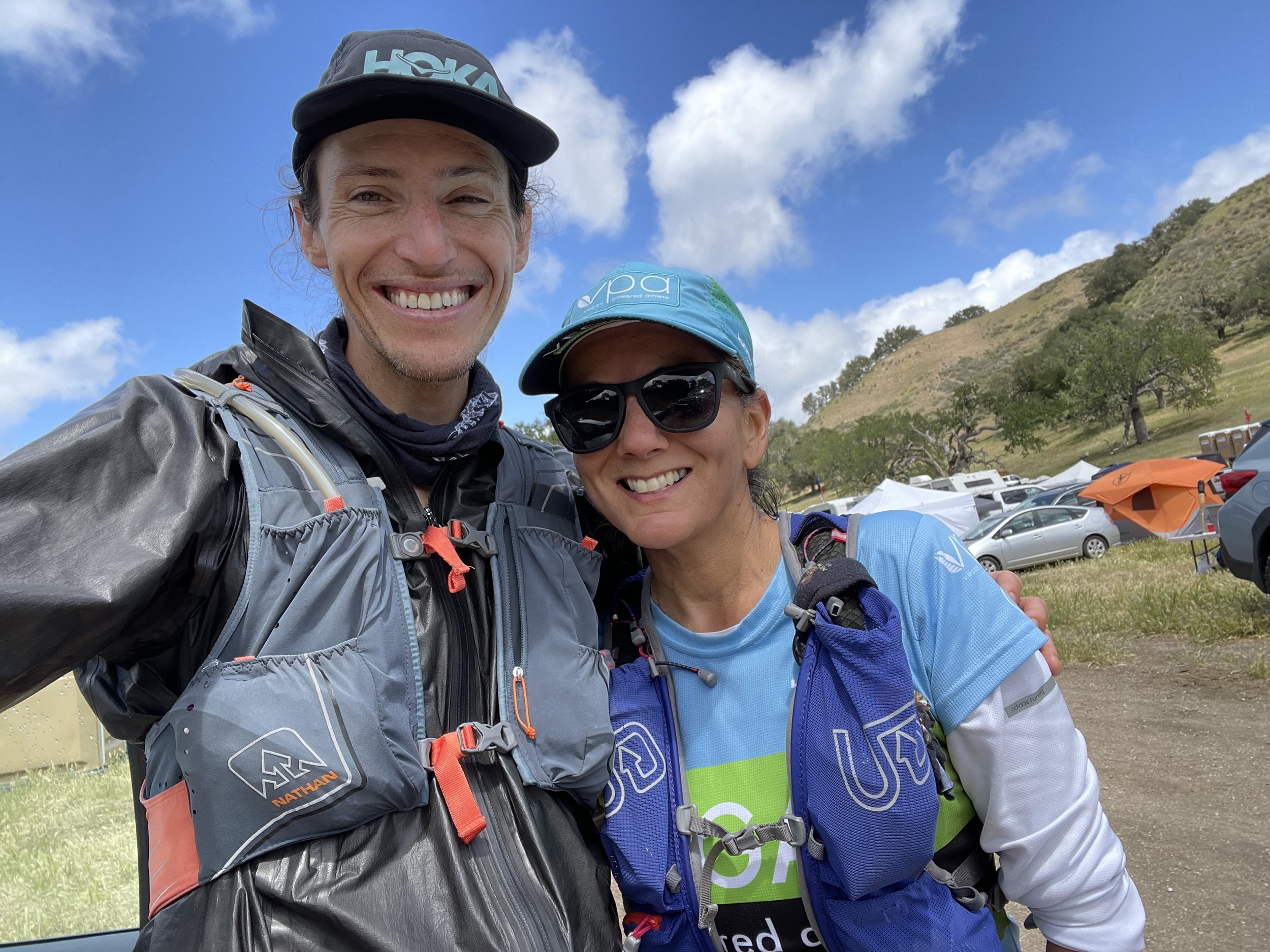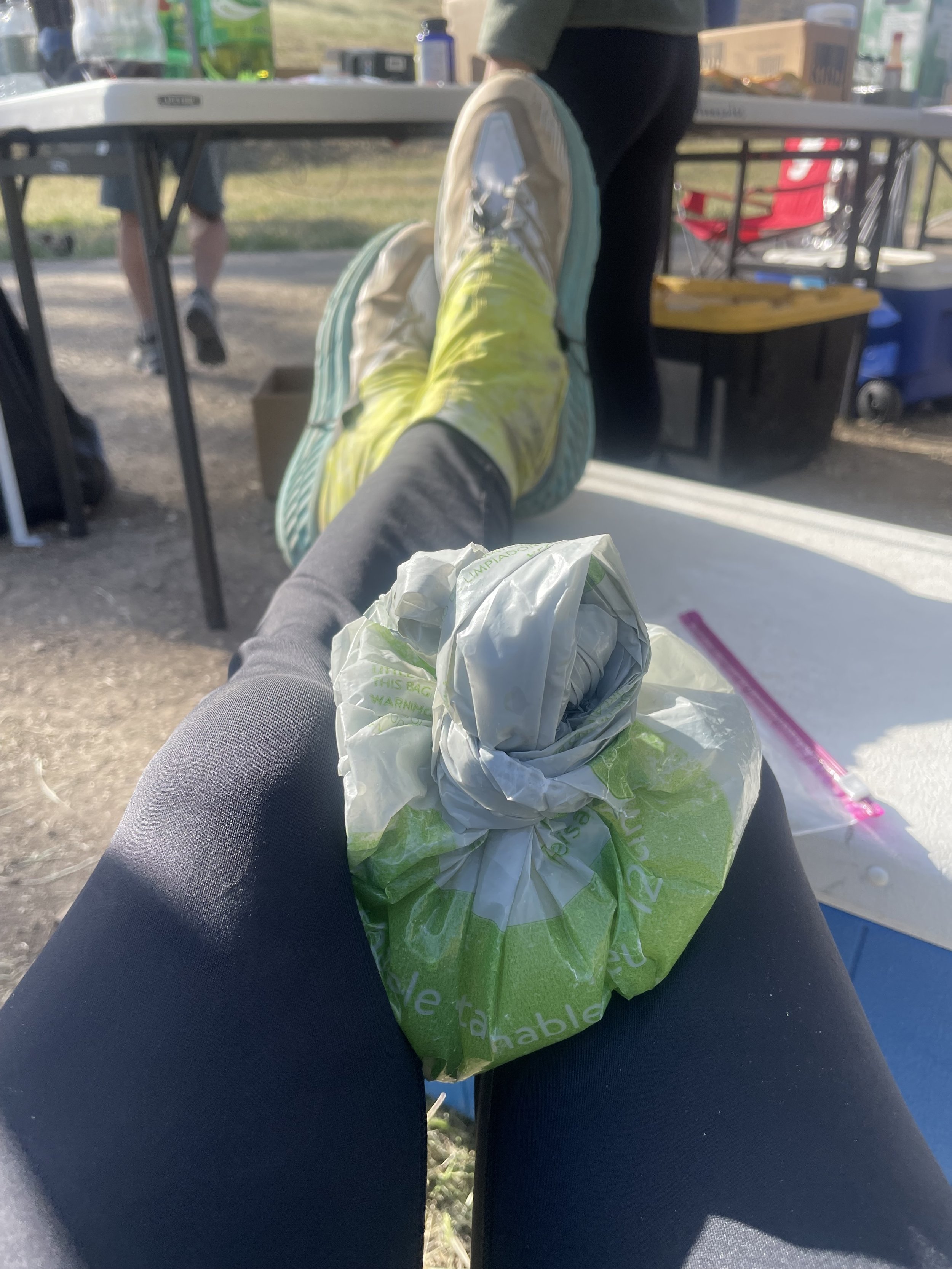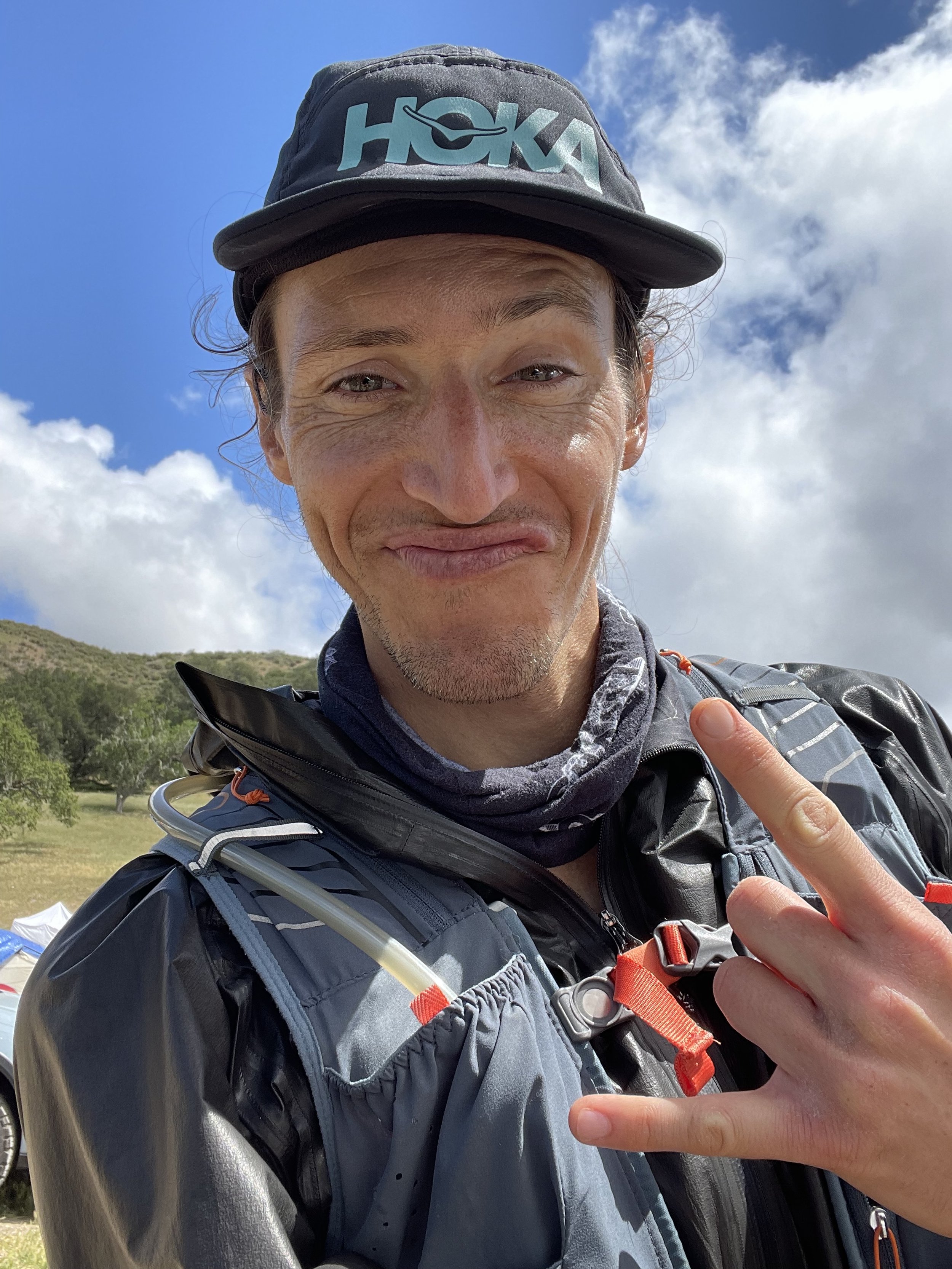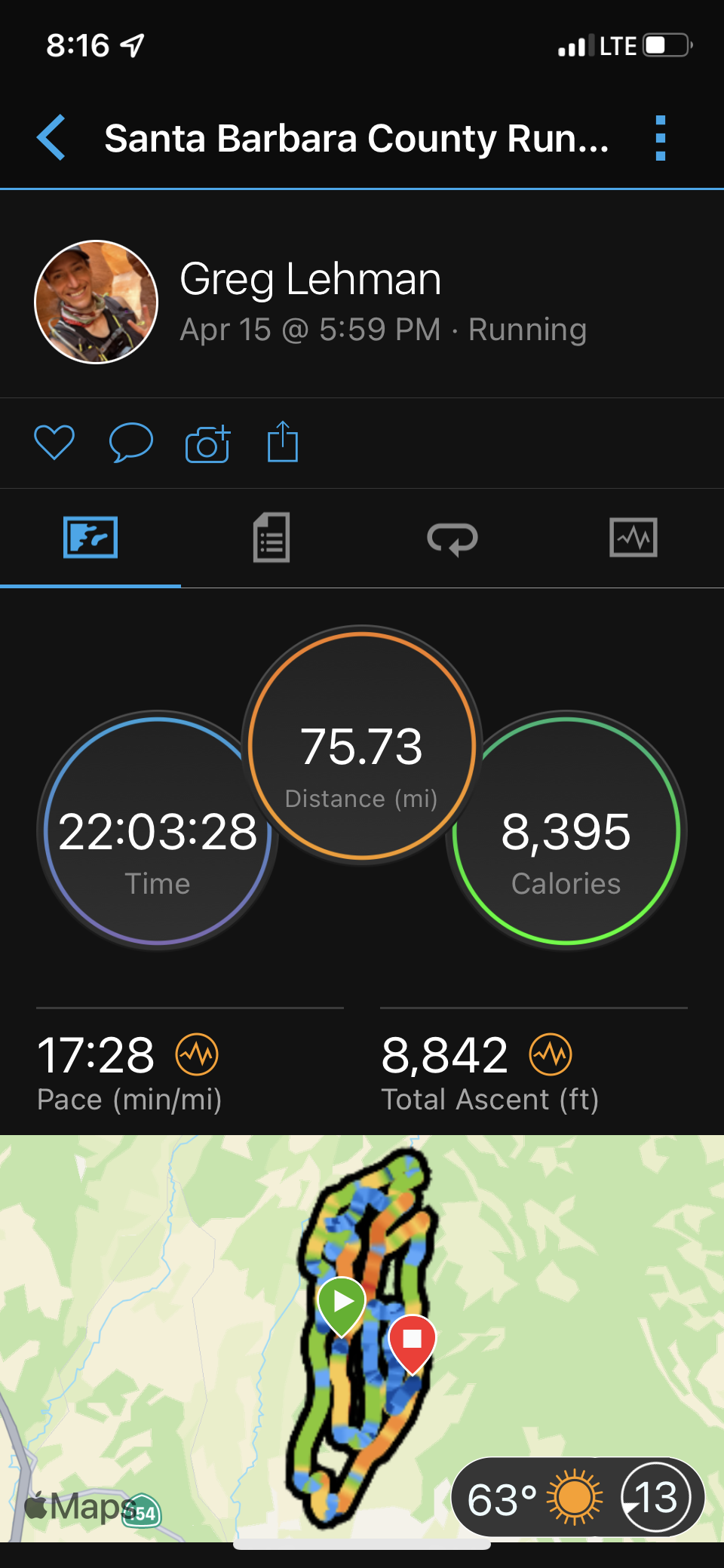Born to Run 100-Miler, Los Olivos, April 15-16, 2022

My experience at attempting the Born to Run 100-miler on April 15th and 16th marks the second DNF of my life.
It came after some of the worst pain I’ve ever felt came, stayed, and proceeded to drill into my right knee after mile 70.
That’s a long ways for me, and I’d gone through no shortage of training, eating, lack of sleep, and practical prep work to get to this point.
After pushing my way to the top of a series of hills at mile 75, I talked to the focal point of my pain with many different voices.
I begged the pain like it was a prison guard, cursed everything it was taking from me like a heartless landlord, the true owner of everything I own. I cajoled it like an athlete I was coaching and really, really needed to make this goal happen for the good of the team.
But, no matter what I did, there it stayed, screaming into my muscles and joints and bones with two words: no more.
Even with all of this, the shared experience I got out of my second attempt at running 100 miles are nothing I would ever take back.
The takeaways were among the most valuable I’ve come across, running or otherwise.
Everyone, from the organizers to my fellow runners to all of the volunteers who selflessly and cheerfully gave me whatever I needed, all in some of the deepest wells of pain I’ve seen so far, were nothing short of the best.
The course, set on a privately-owned cattle ranch in Los Olivos, California, is also among the most beautiful terrain I’ve seen as well.
And extended bouts of running alone with a full moon on these trails stand out as some of my favorite memories at any point in my life.
However, I am clear-eyed about failure.
To not be is to not live in reality, and that’s hard enough to piece together at times.
But a real gut-punch of a defeat is one of the most direct types of evidence we have that something truly happened.
And I want to be a person who understands what happened, meets failure with a willful optimism, and makes moves to foster what I can to keep moving forward.
To start before the beginning, 60 to 70-mile weeks leading into April were amazing. I love to train and race, and discipline that this particular workload demands continues to be the lifestyle that gives me the most fulfillment and personal growth I can ask for, not to mention the incredible social circles and destinations that come with the terrain.
That said, all kinds of stressors decided that two weeks before game day was the time to show themselves. It’s a bit of a laundry list, including someone deciding to smash the back window of my car for no reason, a radiator fan fix with a price tag over $2k, and a few other first-world problems I’m privileged to be able to take care of on my own.
But, their emotional weight was significant.
And even though I aim for grace and patience, I fall short plenty. The times I was tested to see how far both could go with me were very trying, and I’m glad to say I came out whole.
In my conversations with my coach, Kris Brown, reassured me that having the gargantuan task of a 100-miler, front and center, and coming on quick, was the reason why they were taking their toll.
This rang true. I kept my eyes ahead, and thankfully the costs of the side missions did not detract from the primary objective more than I could handle.
Soon enough I was zipping away up the beautiful 101 to my hotel in Lompoc, about a half-hour drive from the privately-owned cattle ranch where the Born to Run event has been held for the past 11 years now.
I read Christopher McDougal’s Born to Run many moons ago. I’d call it an essential read for any runner, its strengths including a deep dive on how human evolution was aided in no small part by running, a revealing history of athletic footwear, and a revelatory glimpse of the singular and inspiring people that are the Tarahumara of northern Mexico.
The fact that the book’s message and a number of its characters seeded the event I was headed into, as well as hearing that the primary goal was embracing and supporting the trail running community, sounded exactly like the type of ride I wanted to take for my second attempt at the 100-mile distance (more about that here, with special thanks to Tyler Andrews and everyone at Chaski Endurance Collection).
For me, to actually enter the Born to Run campsite was to see a trail runner’s dream. Or at least this trail runner.
I drove up to a makeshift village of trailers, tents, and cars in a beautiful valley section of the ranch. I asked a new friend where to park, and he informed me it’d be best to wait a few for the beer mile to finish.
As if on cue, in they came.
A cloud of dust, goofy costumes, and laughter, all wheeled in front of my car, twisting around a hairpin turn to sprint back the way they’d come and chug another round as soon as possible.
The introduction was a fine sampling of what the rest of the event’s spirit would be: a joyous, rough-and-tumble community open to all, working hand-in-glove with a sport that hinges on pushing hardship, never caring about how dirty you get in the process, and where working through fatigue, hunger, thirst, and all manner of unforeseen crises is the entry point.
Or not. You can just come out and party, run no miles the entire time, and be as welcomed in as anyone else.
Once the mile was done, I caught a parking spot maybe 200 feet from the starting and finishing line. This was an ideal place for crewing myself, and a safe but very reachable distance from the Port-o-Potties.
With a starting time at 6:00 p.m. I had a tight hour and a half to suit up, get caffeinated, and step up to game time.
I saw and clapped hugs around a bunch of friends in that electric, oh-my-god-here-we-go time frame runners know so well. I snapped a ton of pictures, and enjoyed a pre-race briefing that involved a risqué Easter bunny, then encouraged people to introduce themselves to the crowd, as well as to fellow runners on your right and left.
Everyone wished me well, and nervousness gave way to giddiness as go-time went from close to now.
Per tradition, Race Director Luis Escobar loaded his shotgun, pointed, and fired.
And away we went.
The 100-miler at Born to Run consists of running 10 times around alternating pink and yellow loops. Starting with pink, one gets just over 1,600 of climb at slightly under 10 miles, and yellow goes over 10 miles with about 2,100 feet of vert.
Hardly easy. But, on paper, the assignment aligned well with the training I’d been doing.
From the start, I kept things smooth and relaxed, holding my pace at over 10 minutes per mile with my shoulders low, arms loose, and eyes set on the last of a beautiful afternoon fading over fields and forest before the night started.
The evening progressed leisurely, like I did, and I was prepared for the night with a headlamp, one of two I brought, along with a stunner of a mini-clip-on light by Energizer.
My heart rate stayed low, and the views stunned in every direction, complete with a very full moon rolling over the rich variety of oaks that are prolific in Los Olivos.
After I completed my first loop, I got back to my car, slammed an A SHOC per my caffeine plan, inhaled a protein bar, and layered up for the cold.
My friend and recent 100-miler conquerer Kaci Yang gave the good advice of prioritizing warmth, especially in the thick of fatigue. This was a critical move, especially when the bladder in my hydro pack decided to leak and leave my back soaking early on.
It’s an older bag so I should have replaced it, or at least run with this one in particular sometime before game day. Try as I did, the source of the leak eluded me, but the bag itself still held enough water that I didn’t need to replace it outright.
But it’s not news that being warm and dry beats the alternative. So my HOKA x GORE-TEX jacket yet again earned its place as one of my most valued items I own in this situation. Any lightweight jacket this strong, packable, and water-resistant is a must for long adventures for me. This one in particular is also comfy enough to rock on its own without a shirt, in my experience.
Another, very different trial came in the form of a wrong turn around mile 16.
One of the strengths of the event were very clear markings on the course. But my first go on the yellow loop found me missing a critical turn.
I’m glad I caught the mistake early, but it’s disheartening at any distance. Still, I’d much rather screw up earlier than later on any course, much less an ultra.
I collected an extra quarter mile or so, then took the about-face too fast, which came with stress and the idea that I needed to make up for lost time.
This, of course, is nonsense during a 100-mile race.
Given the outcome, this was a good lesson: when frustrated, I can’t go wrong with holding perspective, taking the pace down to a crawl, and relaxing.
I completed the second loop, took off too fast again, then slowed down to take caffeine out of the pilot’s seat.
Frogs and packs of coyotes made excellent soundtracks as I stacked more miles, feeling solid until I started the fourth loop, where the real start of difficulty was ready to meet me.
Knee pain will find me in different knees during training for different events. It’s an inconsistent nemesis of mine, but hadn’t shown itself at all during the high volume peaks that came with training.
But here it was. I knew what it could turn into if I wasn’t smart, so I started hiking the hills to conserve energy, which rose in importance as lack-of-sleep started to become a priority.
Sleep deficits make themselves known pretty quickly for me, and I could tell I was getting sleepy. I had gone in with the aim of not sleeping at all during the race, so it was disappointing to feel like my circadian rhythm was taking away from my game plan.
Still, I had everything I needed.
I kept telling myself what was working in the moment, and repeated personal mantras a my friends had shared with me. Saying the word “believe” aloud on its own works wonders, special thanks to my friend Mayra Garcia for that one.
After completing 50 miles and with morning coming on strong, it was clear that I would need to sleep. I wasn’t happy about it, and these feelings lent themselves to serious temptations to throw in the towel. But whether I stopped or not, there just wasn’t any way out of catching a nap, even if just for a little while.
I hobbled into my car and took a nap for about half an hour.
Waking up, I was resolved to finish.
I felt bad sleeping, but after making a new friend in Charlie, a fellow runner in a neighboring car, he was quick to say, “Oh, man, don’t feel bad at all, I slept two hours.” Another comrade chimed in to say he’d slept three.
When in doubt, make new friends and sleep more.
I was in great company, felt fresher than I had before (if not fully bright-eyed and bushy-tailed), and was fully committed to finishing this beast off.
Coming back to camp after 60 miles saw me recharging with old friends, seeing Heather Huggins take the win for the women’s 50k, good conversations, and the least-healthy meal I’ve had in recent memory: a log of a breakfast burrito loaded with chorizo, refried beans, eggs, and salsa. Calories were the headline, and I was happy to gorge myself on a new variety beyond what I’d brought with me (all of which I love: peanut butter and jelly sandwiches, GU Energy gels, oranges, and Kirkland Signature protein bars).
The pain that had been growing in my right knee turned serious, an insistent klaxon that was only getting louder.
I was encouraged in no small part by the people and resources I had in abundance. But I was worried.
Even so, off I went into the sixth loop. Pink again, so “easier,” but rain arrived around mile 64, sticking mud to my shoes and taking my stride down to a grueling slog.
Not thinking I needed to bring trekking poles to this distance was a big mistake.
At mile 70 the pain in my knee had turned up into stabbing, “absolutely no more” levels.
Still, I kept moving forward. It was all I had.
Given my job and the brand I work for, I completely appreciate trying to minimize the impact one takes on their body by running, especially downhill, since three times your body weight is driven down through your feet on a slope.
To take the pace down to a walk, though, is to offer more time to the impact. Running gives the brunt of the force less bandwidth and claws to take to joints and muscles.
But for me, this was too tall of an order to ask after 70 miles.
I’d been at it for over 20 hours at this point, and found myself in one of the most exhausting and infuriating positions I’ve been in so far.
I took a breather at the top of the rolling hills in the middle of the loop when another runner and I exchanged check-ins.
I told her I wasn’t in a good place and might have to call it.
She empathized well, and said it might be good to sit and take in the environment for a bit.
I loved the idea and was quick to take a seat.
My new favorite person Jesse walked up then with trekking poles. He asked how I was, I told him, and he said, “Hey, here, take one,” and offered me a pole.
I appreciated the offer, and together we talked through some of the most excruciating steps I’ve taken towards the next aid station.
As we descended the steepest section, another new friend from the aid station was walking up the way we’d come. We asked what was going, on and he said he was heading for a runner who might have to DNF.
“That’s me,” I told him, and he told me the first runner had told to them about me. I was very grateful for how she was looking out for me, and Jesse and our new friend, Cam, walked with me to the aid station, where more new friends, Mark and Heidi, took excellent care of me as we waited for a ride.
I kept my leg up and the knee iced. I tried turning it, and the joint said, in no uncertain terms, that more mileage was off the table.
Cam kept saying I was going to finish, as did Kris, saying I should wait a while, even a long time, given that cutoff was noon on Sunday.
I completely disagreed.
Going in, I had full faith that I would finish. I did not want to DNF. To do so was a loss, but I had no choice in the matter. I know my body, but even I didn’t, the pain was bigger than anything I could bring against it at that point.
I tried to be gentle with myself, and for the most part everyone was of the opinion that these things happen and that, naturally, siding with what I felt over what I might be able to do was a bet on good health.
Luis’ friend Jerry gave me a ride back to camp. Like everyone else at Born to Run, he was generous and defined cool, and gave me some of the best laughs I could ask for as we made our way back into the open arms of the camp.
I cracked into one of the beers I brought with me, met up with people I know, and was quick to make even more new friends. I wolfed down more food, and stuck around long enough chat with other 100-milers coming through for the home stretches to their last few laps, or even last lap.
I couldn’t stay long, though. I’m amazed I was able to stay conscious as long as I did. Even so, it was difficult to leave, and I will be back.
To leave the property, you have to open and close a large cattle-farm-sized gate at the turn off the main road. It’s not especially heavy, but approached impossible as I limped along with the railing one way, then the other, and all but fell back into my car.
Based on that, I had no doubt that my odds of pulling off another marathon were 200% against, in the most generous terms.
Even getting back to the camp on my own to sleep and keep going after would’ve required another 5 miles of hiking, on a fairly difficult profile.
Failing that, I would’ve been picked up on the trail somewhere.
I treated myself to the best Chinese beef and veggies of my life on the way back to Lompoc. Still hungry, I put down a Stroopwaffle and orange in my room. It’s gross, but I was too tired to shower, and proceeded to sleep 12 hours in a very dirty bed.
The active approach to problems is always a good look in my book.
After being canceled due to fires in Oregon in 2021, my entry to Pine to Palm 100 is set for September 10th, 2022.
The day after Born to Run, I immediately started a spreadsheet of new extended trail adventures to take on in preparation for my next attempt at the distance.
It felt amazing to let my imagination run wild through Strava and AllTrails, guided by recommendations from friends and with an eye on out-performing previous training lists I’ve put together.
Kris and I had one of my favorite chats soon after.
I told him about how I struggle with the thought of how I might be a 100k and under type of person, that my energy might be better served at these distances over beating myself madly, uselessly against the 100-miler.
The inner conflict, of course, is never wanting to back away from a challenge I find fascinating, terrifying, and worth whatever effort and personal development I can bring to it.
He did me worlds of good when he pointed out that I’m relatively new to the sport (my first ultra being Speedgoat 50k in July 2019, my longest Timberjack 100k in September 2021), and how people will usually spend many years honing the craft of taking on ultra distances before slowly, carefully stepping into the range of a 100-mile effort.
Kris assured me that I have time, and lots of it.
I’m never sure of that, but if I am lucky enough to have a lot of life ahead of me, I will be grateful to keep committing my energy and resources to continued growth in this sport.
The 100-miler is looking at me, especially after two rounds, and I’m looking right back with humility, enthusiasm, and appreciation for the privilege in my heart.
See you soon, Pine to Palm 100.
Huge thanks and hugs and another see-you-soon to everyone at Born to Run as well. That 10-miler in 2023 looks particularly enticing, since those beautiful Los Olivos trails continue to call me, as does giving bandwidth to the festivities and socializing that come with this incredible event.
As does that beer mile, of course.







